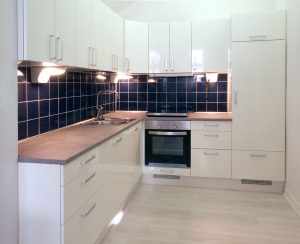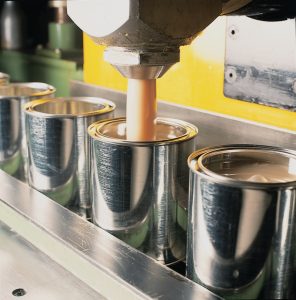If you’re thinking of sprucing up your home, but feeling a little overwhelmed by all the paint choices, our guide explains the many different types of paint available and which rooms they work best in. After all, choosing the right paint finish is just as important as choosing your colours!
There are two easy rules to remember when choosing paint sheens:
- the higher the sheen, the higher the shine
- the higher the shine, the more durable it is
So to know your eggshell from your emulsion, read on…
Eggshell
Eggshell really does look a little like the surface of an eggshell and gives a lovely, classic finish to wood without a shine. It can be used on walls too if you’re after a traditional, vintage look with a tough finish. It covers any imperfections, resists stains and can be wiped easily with a wet cloth. It looks great in living or dining rooms and kids’ bedrooms.
Gloss
Gloss has a very shiny finish that reflects a lot of light. It’s great for pale colours and very practical as it’s easy to clean, though you need a perfect surface underneath or it’ll show all the lumps and bumps. It’s perfect for kitchens, doors and window trims.
High Gloss is super shiny and very hardworking. It’s particularly good for areas that might be touched by sticky fingers, like cabinets and doors, or window and door trims, but it’s too much for walls.
Semi Gloss is great for rooms where moisture or grease is a challenge. It’s just as hardworking as high gloss and great for kitchens, bathrooms and kids’ bedrooms because it stands up to water and regular cleaning.
Matt Emulsion
This is a water-based paint that isn’t shiny when it dries because matt surfaces don’t reflect light; they soak it up. It gives a really smooth finish and is good for hiding any imperfections on uneven walls. It also provides the most coverage for your money, so it’s good for your pocket too. It works well in bedrooms, though because it’s pretty tough to clean without taking the paint off with the dirt, it’s best for adult bedrooms and not kids’ rooms.
Satin
This gives a slightly polished and velvety finish to a wall, which reflects a little bit of light, but it’s most often used on wood, where it helps to hide any unevenness and gives colour a softer edge. It’s good for kitchens, living rooms, hallways and kids’ bedrooms as it can cope with high traffic and it’s very easy to clean, though the downside is that you have to be really careful applying it to avoid leaving obvious brushstrokes or roller marks. It also works well on windows, doors and ceilings.
Silk
Like satin, silk also gives a slightly polished finish, but it’s more often used on walls instead of wood. You can wipe silk walls really easy, which makes it a very practical finish, but because it does reflect a bit of light, you will be able to see any unevenness if your walls aren’t perfectly smooth. It’s great for kitchens.
Masonry
Masonry paint is a designed to decorate and protect masonry – that’s the bricks, concrete or stone that make up the exterior of a building. You’ll usually need a primer and to make sure all the cracks are repaired or filled before painting. You can’t use ordinary paint on masonry because moisture needs to escape, brick and concrete can flake and there’s dust and potential chalking issues. The paint has to be elastic, breathable and strong. But as long as you’ve prepared and primed the wall properly, any quality exterior weatherproof paint will work as masonry paint.
Non-VOC Paints
VOC stands for volatile organic compounds. Normal paints release a variety of these, which were, until recently, essential for the performance of the paint and often caused headaches, dizziness and nausea, the effects of which could last up to five years! Non-VOC paints release low level toxic emissions into the air, but it’s always worth checking the paint label as even some paints that say they’re eco-friendly, still contain VOC solvents, like formaldehyde. If you’re planning to go green, plant-based, waterborne paints with natural solvents are the best, though they can be difficult to get hold of and are much more expensive. Try green online outlets for brands like Biofa, earthBorn, EcosAglaia and Auro. Truly eco paints can be used everywhere in the house and are available in a range of finishes, but are ideal for children’s rooms and toys.


